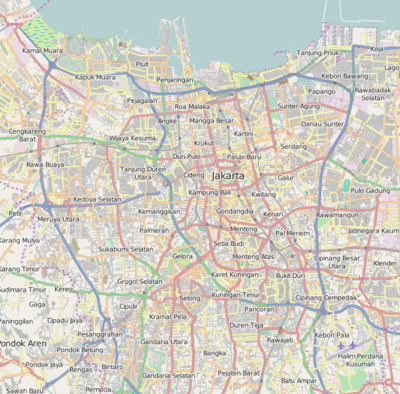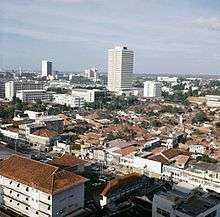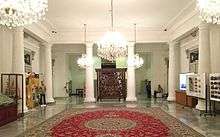Jakarta City Hall
| Jakarta City Hall | |
|---|---|
| Balai Kota DKI Jakarta | |
|
The refurbished 24-floored Building G, the main administrative office of the Jakarta City Hall complex. | |
 location within Jakarta | |
| General information | |
| Type | City hall |
| Architectural style | Building in various styles: Indies Empire style, International Style |
| Location | Jakarta, Indonesia |
| Address | Jl. Medan Merdeka Selatan No. 8-9, Jakarta 10110 |
| Coordinates | 6°10′52″S 106°48′44″E / 6.18111°S 106.81222°ECoordinates: 6°10′52″S 106°48′44″E / 6.18111°S 106.81222°E |
| Owner | Pemda DKI Jakarta |
| Website | |
|
www | |
Jakarta City Hall (Indonesian Balai Kota DKI Jakarta) is the seat of Jakarta City government. The complex of Jakarta City Hall contains the official office of the governor and the vice governor of Jakarta, and the main administrative office. The Jakarta City Hall is located south of Merdeka Square. complex consists of several buildings used for the government work of the city of Jakarta. The article covers the historic Jakarta City Hall complex located in Jalan Medan Merdeka Selatan.
History
Dutch colonial period

The first city hall of Jakarta was built on 4 March 1621 together with the development of the city Batavia. This city hall, which has been converted into the Jakarta History Museum, was the original administrative center of Batavia.[1]
On 1 April 1905, the Gemeente Batavia (Batavia City Council) was formed to allow greater autonomy in the management of the colonial capital. Initially, the council still operated from the old City Hall in the Old Town. The growth of the Batavia to the southern area of Weltevreden forced many government buildings to relocated their address to the south, including the city hall. In 1913, the council was relocated to Tanah Abang West (now Jalan Abdul Muis no. 35). In 1919, the council was relocated to the current building in Koningsplein Zuid (now Jalan Medan Merdeka Selatan no. 8-9).[1][2] At that time, the building no. 8 was used for the office and residence of the Resident of West Java, while the building no. 9 was the Gemeentehuis Batavia and the official residence of the Burgemeester. The building no. 9 was fully converted into a city hall when the official residence of the Burgemeester was relocated to a new building near the Bisschopplein (now Suropati Park), now located in Jalan Suropati 7.[1]
On October 1, 1926, Gemeentehuis Batavia became the Stad Gemeentehuis Batavia.[3]
Japanese occupation and National Revolution
During World War II, the building was used for the office of Jakarta Special City (ジャカルタ特別市 Jakaruta tokubetsu-shi), headed by a sityoo. After independence, the name of the building became the Balai Agung Pemerintahan Nasional Kota Djakarta ("Great Hall of the National Administration of Djakarta City") with Suwiryo as its first native mayor. Since then, Jakarta's administration continued to be based in the same building.[3]
On July 21, 1947, the new administration of Jakarta was unable to operate when Suwiryo and the new government of Jakarta was derived out of the office by the Dutch government whom at that time had not recognized the Independence declaration on August 17, 1945. On March 9, 1948, the Dutch government formed a pre-Federal governorship to replace the former governance and converted Jakarta into the capital of the country. The name was reconverted to Stad Gemeente Djakarta and remained so until the recognition of the independence of Indonesia on December 27, 1949 by the Dutch Empire.[4]
Post-National Revolution
Since March 31, 1950, Soewirjo was reappointed as mayor of Kotapradja Djakarta (Jakarta municipality). Around 1954, the city hall was expanded to include the building no. 8, hence now Jakarta City Hall occupied two building plots of 8 and 9. The office building of the High Commissioner Kingdom of the Netherlands which were located next to Jakarta City Hall was also used as government offices for the Regional Representatives Council of Gotong Rojong (Dewan Perwakilan Rakyat Daerah Gotong Rojong). Office of the High Commissioner of the Kingdom of the Netherlands were then relocated to Jalan Medan Merdeka Barat.[4]
Next development

From 1960, Jakarta was headed by a governor after Jakarta's status was upgraded from municipality (kota pradja Djakarta Raja) to province (Daerah Chusus Ibu Kota (DCI) Djakarta).[2] In 1964, Jakarta was officially the capital of Indonesia.[3] 1960, i.e. the tenure Sumarno, Jakarta get special status be level with Swantantra Regional Level I. The name 'Township Government Djakarta Raja' was changed to the Government 'Special Capital Region (DCI) Djakarta '. Head of government was no longer called the mayor, but changed to the governor. And in 1964, Jakarta was officially the capital of the Republic of Indonesia.
In 1969, the Jakarta City Hall expanded with construction of Building C (Balai Agung) and 4-floored building F.[4]
In 1972, the government of DCI Djakarta changed its name to Daerah Khusus Ibu Kota (DKI) Jakarta following the implementation of the Enhanced Indonesian Spelling System. In the same year, the old colonial building located in plot 9 was demolished to make way for a 24 floors building G. Construction of this building was meant to be a pilot project for other high rises in Jakarta and a reference to lay out new regulations on high rises in Jakarta.[3] In the same year, the complex of the City Hall was expanded toward Jalan Kebon Sirih with the construction of building H. Afterwards, new buildings were established in the complex, which include building D and building F. In 1982, the DPRD DKI building was constructed in Jalan Kebon Sirih.[4]
Now

During the tenure of Governor Basuki Tjahaja Purnama, the colonial City Hall building at number 8 was opened for public on September 12, 2015.[5] Pengunjung juga dapat menyaksikan berbagai film Indonesia yang diputar setiap akhir pekan di Gedung Balai Agung.[6]
References
Cited works
- Merrillees, Scott (2015). Jakarta: Portraits of a Capital 1950-1980. Jakarta: Equinox Publishing. ISBN 9786028397308.
- "Gedung Balaikota" [City Hall] (in Indonesian). Jakarta City Administration. Archived from the original on November 7, 2016. Retrieved November 7, 2016.
- "Balai Kota, Gedung" [City Hall] (in Indonesian). Jakarta City Administration. Archived from the original on November 7, 2016. Retrieved November 7, 2016.
External links
| Wikimedia Commons has media related to Jakarta City Hall. |
- Gedung Balai Kota
- Jakarta Balai Kota
- Sejarah Panjang Kompleks Balai Kota Jakarta
- Wisata Balai Kota Resmi Dibuka
